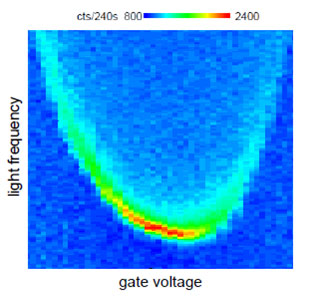| Jul 01, 2011 | |
Shedding light on Kondo correlations |
|
| (Nanowerk News) In a recent publication in Nature ("Quantum quench of Kondo correlations in optical absorption"), scientists from ETH Zürich, LMU Munich (amongst others NIM member Professor Jan von Delft), Princeton and Yale Universities have used resonant laser absorption to examine how a quantum dot with Kondo correlations responds to a quantum quench, i.e. to an abrupt change in the interactions that give rise to Kondo correlations in the first place. | |
| One of the most celebrated phenomena in many-body physics is the Kondo effect, which describes how the tiny magnetic field associated with the spin of a single localized spin is screened by delocalized spins of an electron reservoir. In the past decade, the effect has been extensively studied in quantum dots, i.e. in nanoscale semiconductor structures in which single electrons can be captured and manipulated. These studies focused on the influence of the Kondo effect on the electrical resistance of such a quantum dot. | |
 The present study adds a new dimension by reporting optical measurements. It shows that, remarkably, the interactions that give rise to the Kondo effect can be switched off by the absorption of a single photon, and yields detailed insights into the subsequent decay of Kondo correlations. The Munich part of the project was performed by Markus Hanl, Andreas Weichselbaum and Jan von Delft from the Nanosystems Initiative Munich (NIM), who provided theoretical modeling of the experiment. The study initiates a new direction where quantum optics techniques are used to study many-body phenomena. The experiment studies the absorption line-shape (the absorption rate as function of frequency) of photons incident on a quantum dot that was designed to be quite strongly coupled to the delocalized electrons in the surrounding material. Moreover, the quantum dot was tuned such that its absorption properties are dominated by only a single electron, localized in this dot. Before photon absorption, the dot exhibits the Kondo effect: the spin of the localized electron is strongly correlated with the spin of delocalized electrons, which act to screen the spin of the localized electron, thus reducing its magnetic moment. When an incident photon is absorbed, another electron is excited from a low-lying (valence) energy level into the same level that contains the first electron. This sudden change constitutes a quantum quench. It disrupts the Kondo correlations with the delocalized electrons in the surrounding material, causing the Kondo effect to die out shortly after the quench. Thus, the initial and final state of the delocalized electrons are very different. This difference was first characterized by P.W. Anderson in 1967, who coined the phrase "orthogonality catastrophe" for it. Anderson's orthogonality catastrophy leaves subtle but tell-tale signatures in the absorption lineshape, namely power-law behavior with characteristic exponents that reflect the degree of orthogonality. The present experiment succeeded in detecting signatures of these power laws in the measured lineshapes; a smoking gun for their presence was that the corresponding power-law exponents could be tuned by applying a magnetic field, in good agreement with the theoretical calculations of the Munich physicists. |
| Source: LMU Munich |
